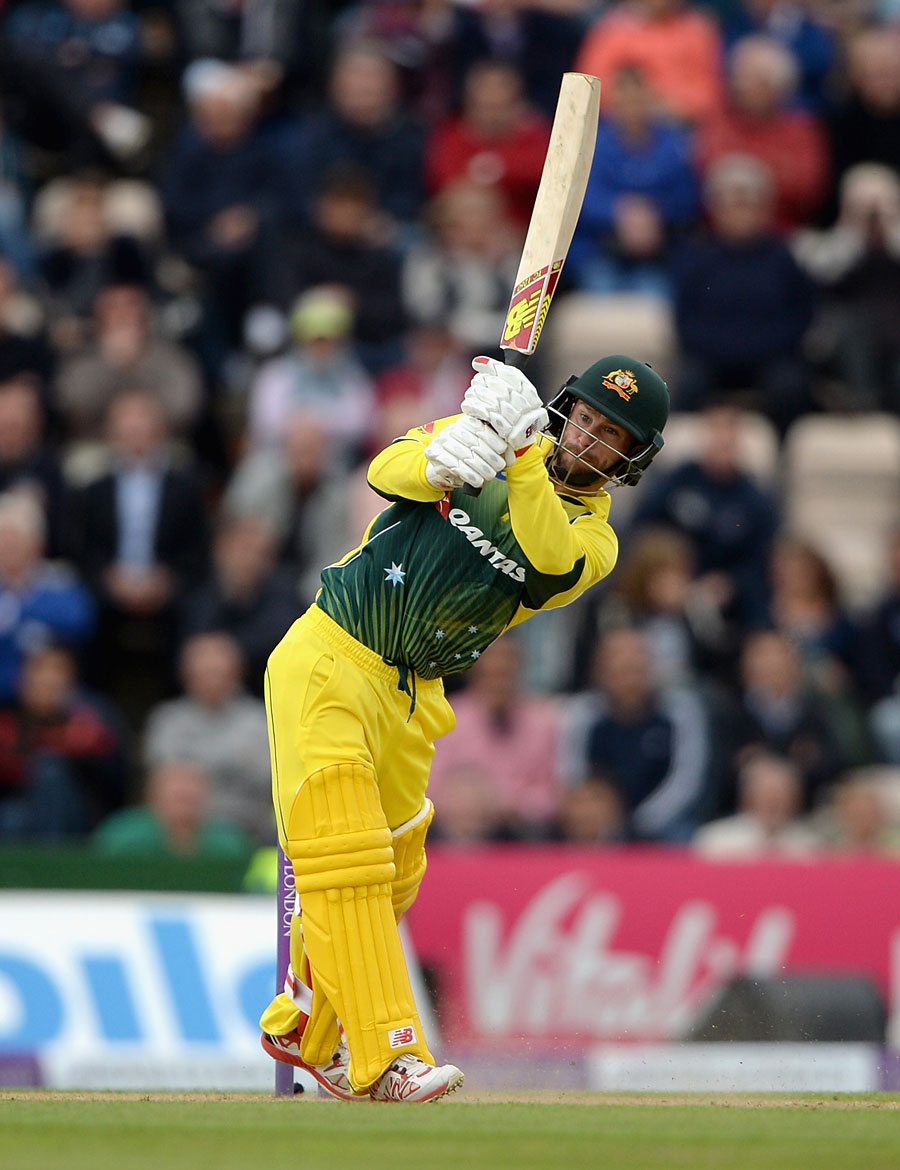A seventh-wicket partnership of 112 in 13 overs between Matthew Wade and Mitchell Marsh proved the difference between the sides in the first ODI of the series between England and Australia in Southampton.
When the pair came together Australia were precariously placed on 193 for 6 and had just lost three wickets for 15 runs. But Wade, timing the ball as well as anyone, produced his highest ODI score since August 2012 – and his highest ever against a Full Member nation – as Australia added 93 from the final 10 overs.
That took Australia’s total above 300 and, while the game has changed up to a point, the fact remains that England have only three times successfully chased a target of that magnitude. Only once have they successfully chased a target higher than the one they were set here.
There was talk, at the halfway stage of the game, that the Australia total was little better than par. And it is true that, in the context of the run-drenched ODI series against New Zealand earlier this season, a score of 305 seemed pretty modest.
But maybe in time we will come to see that series – played on perfect batting pitches and with playing regulations that favoured batsmen to an extreme extent – as somewhat aberrational. This was the first ODI in England played under the new playing regulations which allow the fielding captain more scope to defend. It is too early to say for sure what the effects will be, but it seems reasonable to presume they will rein in totals just a little.
England’s openers set off well enough but eventually, against a disciplined attack, the pressure of sustaining such a run chase began to tell. And, once their innings lost momentum, wickets followed.
This was a performance that represented a fine return from Wade. He missed out on World Cup selection after Brad Haddin’s superior keeping and extra experience – and his own failure to nail down a place in the 47 ODIs he had played up to that point – was favoured.
Until that point, Wade was averaging in the mid-20s and, after a decent start to his ODI career (he made three half-centuries in his first nine innings), had contributed just one half-century in 22 innings.
He didn’t enjoy a good start here, either. Attempting to get off the mark, he pushed a delivery straight to the cover fielder – Ben Stokes of all people – and set off for an almost impossible run that left his partner, the unfortunate Shane Watson, yards short of his ground.
But after that moment of madness, he demonstrated a fine range of strokes, a selflessness and an ability to improvise – one sweep off Stokes was especially eye-catching – to suggest that, aged 27, he has the ability, the time and now the maturity to make a success of his second chance in international cricket. He also kept athletically and claimed three catches.
Certainly Australia were grateful for his contribution. While David Warner and Joe Burns ensured a bright enough start, Australia lost their way in mid-innings due to the introduction of England’s spinners and some self-inflicted errors. First Burns hit a full toss straight back at the bowler, before Steven Smith slogged another straight to the fielder on the deep midwicket boundary.
Adil Rashid was the fortunate bowler on both occasions but, in between times, this was a decent performance from the legspinner. Encouraged to think of himself as a wicket-taking bowler, even in this format of the game, he turned the ball both ways and generally maintained a decent, demanding length. On another day the wicket of Warner, who again looked in fine form but was defeated by a googly and sliced to short third man, might have proved crucial, while Rashid could also take pride in the wicket of George Bailey, beaten by one that skidded on.
Moeen Ali, gaining more drift and dip than at any time this summer, also bowled nicely and was the most economical of England’s bowlers. But the seamers claimed only one wicket between them – and that from what might well have been called a leg side wide had Glenn Maxwell not feathered it – which gave Australia the opportunity to launch a counterattack in the final overs.
England’s reply started well, too. Jason Roy, timing the ball as well as he ever has done in an England shirt, raced to his maiden international half-century and with Alex Hales posted a first-wicket stand of 70 in 11 overs. It is a partnership of elegant brutality that promises much for the future.
But after Hales pulled to midwicket, James Taylor was unable to capitalise on his decent start and became bogged down against the impressively tight bowling of Watson and Maxwell. Roy sliced to point, Taylor played across a straight one and Eoin Morgan’s uncomfortable innings was ended when he gloved an attempted pull down the leg side.
That wicket seemed to break the back of England’s resistance. Stokes’ unconvincing innings was ended by a flick to midwicket, Jos Buttler drive to mid-off and, with Mitchell Starc and Pat Cummins bowling with impressive pace, the tail were never likely to stay with Moeen long enough to get close.
England have now lost 10 of their last 11 ODIs against Australia. The margin was not as large as the last time they met – on the opening day of the World Cup in February – but Australia showed that, even with four changes to the side that lifted that trophy, they remain a tough team to beat in ODI cricket.
(© ESPN Sports Media Ltd.)


